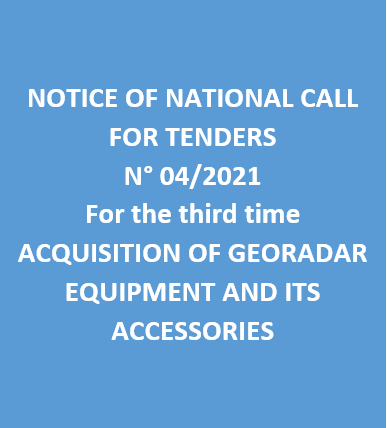| Annual program and technical progress report |
-

Activity Report 2023
-

Technical Program 2024
|
| Geocatalogue |

|
| Invitation to
tender |
-

REALIZATION OF THE TRAINING PLAN FOR THE YEAR 2022
-

ACQUISITION OF TWO SERVICE CARS
-

ACQUISITION OF GEORADAR EQUIPMENT AND ITS ACCESSORIES
|
|
Invest in Tunisia |

|
|
|
|
|
::
Documentation and Editions
>>
Research library
|
| |
|
[
Search by author
]
[
Search keyword
]
[
Search by index
]
[
Search by category
]
|
title of the reference :
|
The influence of peripheral sabkhas on the geochemistry and sedimentology of a tunisian lagoon
|
|
Publication Date:
|
1981
|
|
Author :
|
Medhioub Khaled, Perthuisot Jean Pierre
|
|
Catalogue type :
|
Livre
|
|
Catalogue reference :
|
Vol.28 (NLD) Sedimentology Vol.28 The influence of peripheral sabkhas on the geochemistry and sedimentology of a tunisian lagoon L'influence de sebkhas périphériques sur la géochimie et la sédimentologie d'une lagune tunisienne : bahiret el Biban. bahiret el Biban. Bahiret el Biban is a restricted lagoon in an arid climate. The general geological setting is briefly analysed, especially with respect to the relations between the water body and its evaporitic bordering areas, i. e. supratidal sabkhas. The geochemical behaviour of the lagoon waters has been studied over a 2-year period following floodings. In spite of some exchange with the open sea, there is a general tendency towards increasing salinity, calcium sulphate impoverishment and a consequent increase of the Mg/Ca ratio. Thus, unless large floodings occur, the basin waters undergo an evaporitic evolution. Sedimentation and early diagenesis are controlled largely by this geochemical pattern, but also by exchange with the open sea and by water depth. Organic matter derived from the sea is deposited on entering this highly saline basin and locally produces sediments which could eventually become source rocks. Bahiret el Biban is a possible model which may be of considerable interest in the reconstruction of the carly stages of the evolution of evaporitic basins. bibliogr. sédimentation lagunaire ; sebkha ; calcium ; magnésium ; sulfate ; salinité ; cycle géochimique ; eau saumatre ; Tunisie ; Tunisie Sud Orientale ; Bhirat el Bibane Perthuisot Jean Pierre Medhioub Khaled Géomorphologie, Pédologie
|
|
Indexation decimale :
|
Géomorphologie, Pédologie
|
|
Keywords :
|
sédimentation lagunaire ; sebkha ; calcium ; magnésium ; sulfate ; salinité ; cycle géochimique ; eau saumatre ; Tunisie ; Tunisie Sud Orientale ; Bhirat el Bibane
|
|
Summary :
|
Bahiret el Biban is a restricted lagoon in an arid climate. The general geological setting is briefly analysed, especially with respect to the relations between the water body and its evaporitic bordering areas, i. e. supratidal sabkhas. The geochemical behaviour of the lagoon waters has been studied over a 2-year period following floodings. In spite of some exchange with the open sea, there is a general tendency towards increasing salinity, calcium sulphate impoverishment and a consequent increase of the Mg/Ca ratio. Thus, unless large floodings occur, the basin waters undergo an evaporitic evolution. Sedimentation and early diagenesis are controlled largely by this geochemical pattern, but also by exchange with the open sea and by water depth. Organic matter derived from the sea is deposited on entering this highly saline basin and locally produces sediments which could eventually become source rocks. Bahiret el Biban is a possible model which may be of considerable interest in the reconstruction of the carly stages of the evolution of evaporitic basins.
|
|
Exemplaries :
|
TU864
|
|
|
|
|
|
|
|



